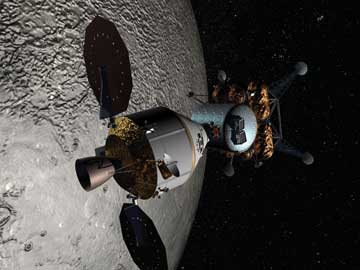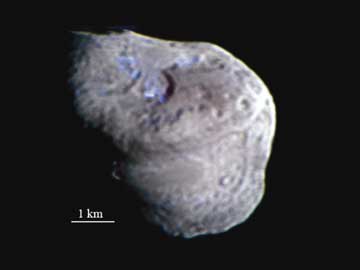|
Highlights 2006
Top space news stories of 2006
Titan’s
earthly and unearthly features
Space technologies fly,
lift and roll on
Deep Impact still impresses
Lava tubes on Mars
For a complete list of space headlines from 2006,
see the December 2006 print issue.
Titan’s earthly and unearthly features
Knowledge about the geology of Saturn’s largest moon Titan exploded last year, when NASA’s Huygens probe touched down on the moon’s icy, rocky surface. But this year, Titan continued to make headlines as scientists studying data from both the probe and from NASA’s Cassini orbiter continued to uncover new information about the planet’s remarkably Earth-like surface.
When the Huygens probe landed on Titan in January 2005, instruments sensed that it came to rest on a wet methane mud. This year, astronomers applied data that was gathered during landing to models, and reported in the July 27 Nature that Titan’s ground is likely wetted by a continuous methane drizzle from a thin, barely detectable layer of methane clouds that cover about 50 percent of the moon. But while the drizzle (about 5 centimeters of accumulation per year) is enough to wet the ground, it is less likely to explain the moon’s many lake- and river-like erosion features.
Such geologically interesting features turned up in new radar images that detail rivers, hills, mountains, valleys and craters on a bright, Australia-sized land mass called Xanadu, according to a July 19 NASA news release. “Surprisingly, this cold, faraway region has geological features remarkably like Earth,” said Jonathan Lunine, a Cassini scientist at the University of Arizona, in the news release.
Then, on July 27, Cassini imaging team members announced the discovery of dozens of dark lake-like features in radar images of Titan’s north pole, which complement a single similar feature found last year at the moon’s south pole; the team had not determined if the features hold any liquid methane or ethane (see Geotimes online, Web Extra, July 31, 2006). A separate team reported Sept. 15 in Science, however, that a large cloud of ethane (a byproduct of methane) hovering at Titan’s north pole could possibly be shedding ethane snowflakes into the lakes.
Even if the features are found to hold methane, however, they would not likely contain enough methane to solve the moon’s atmospheric methane budget mystery, astronomers told Geotimes in July. Essentially, scientists know that ultraviolet light that reaches Titan’s atmosphere breaks down methane and strips it away, so, some source must exist to replenish the gas to the atmosphere, to maintain currently measured levels.
Prior to the Cassini mission, scientists thought that dark regions that encircle and starkly contrast with Xanadu were possibly liquid methane seas that supplied methane to the atmosphere. Images from Cassini revealed, however, that much of the dark regions are not liquid methane seas, but are instead seas of sand with dunes that in some places reach 100 meters high, as reported by Caitlin Griffith, a planetary scientist at the University of Arizona in Tucson, and colleagues in the May 5 Science (see Geotimes, July 2006).
The methane budget dilemma might be better explained by a new model of Titan’s geology, which posits that the gas might currently be stored in a methane-ice crust that covers an internal ocean of liquid water and ammonia, as Gabriel Tobie, a planetary physicist at the University of Nantes in France, and colleagues reported March 2 in Nature. Icy volcanoes might be the conduit that transports methane from the moon’s crust into the atmosphere, and may also account for river-like erosion features.
Time still remains, however, for Cassini to probe for more data. More than halfway through its scheduled four-year-long mission, Cassini still has a fair portion of its total 45 scheduled flybys of Saturn’s Earth-like, yet alien, moon Titan.
Kathryn Hansen
Links:
"Titanic methane mystery solved?" Geotimes online, Web Extra, July 31, 2006
"Dunes on Titan," Geotimes, July 2006
Space technologies fly, lift and roll on
 Amid concern that President Bush’s “vision for space exploration” is cutting into NASA funding for basic earth science research, the president’s plan to send humans to the “moon, Mars and beyond” moved forward this year. NASA and private industry alike unveiled various new technologies for exploring the solar system.
Amid concern that President Bush’s “vision for space exploration” is cutting into NASA funding for basic earth science research, the president’s plan to send humans to the “moon, Mars and beyond” moved forward this year. NASA and private industry alike unveiled various new technologies for exploring the solar system.
In this schematic, the proposed Crew Exploration Vehicle — officially named Orion — docks with a lunar lander in orbit around the moon. The vehicle is planned to return humans to the moon by 2020. Image is courtesy of Lockheed Martin Corp.
On Aug. 31, NASA announced that Lockheed Martin would be the prime contractor to develop and build the new Crew Exploration Vehicle, beating out the combined efforts of Boeing and Northrop Grumman to win the contract. NASA plans to have the exploration vehicle, officially called Orion, return astronauts to the moon by 2020. A Sept. 28 report by the U.S. Government Accountability Office, however, called the program “at risk” for schedule delays, cost overruns and performance shortfalls. According to the report, NASA committed to a “long-term product” before fully establishing project specifics, such as its requirements, technology, design and cost estimates.
Research in private industry also contributed to space exploration this year (see Geotimes, July 2006). The Spaceward Foundation, for example, has been exploring technologies to literally “lift” people and cargo into space. The foundation funds the Elevator 2010 project, which promotes the research and development of an elevator to carry scientists, space tourists and building materials from Earth’s surface into orbit around Earth. The idea is that cargo will be carried into space on electric vehicles that climb up a carbon-nanotube tether that stretches from Earth to an anchor in orbit. The cost is estimated to be 100 times less than the current method of launching cargo on a rocket.
To tackle space elevator engineering obstacles, engineers gathered at the Space Elevator Games in Las Cruces, N.M., in October to compete in the X Prize Cup — an annual event that began last year, following the success of the 2004 X Prize, which awarded $10 million to SpaceShipOne for completing the first privately funded human spaceflight. Also participating for the first time in October’s X-Prize Cup was NASA’s Lunar Lander Analog Competition. Teams demonstrated the ability of crafts to launch vertically, hover and maneuver.
Thinking about future Mars surface exploration as well, researchers continued to develop the next generation of Mars rovers (see Geotimes, July 2006). The Mars Science Laboratory (MSL) will rove across Mars much like its predecessors, Spirit and Opportunity, but will be larger and four times heavier, carrying more scientific tools to determine if life could have once existed on the martian landscape. NASA plans to launch the first MSL by 2009.
Meanwhile, the intrepid rovers, Spirit and Opportunity, continue to explore Mars. They are starting to show their age, however, according to Matt Golombek, a geologist and principal scientist on the Mars Exploration Rover mission at NASA’s Jet Propulsion Laboratory, who spoke to Geotimes in September (see Geotimes online, Web Extra, Sept. 29, 2006).
As of Sept. 30, Opportunity had lost steering to one of its wheels and was driving mostly backward, while Spirit, on the opposite side of the planet, was in worse shape with a broken wheel and an eroded drill bit. Winter darkness has also taken its toll on Spirit’s energy, which comes from solar panels, and Spirit has not moved in months. “Other than that, they’re perfect,” he says — and already more than two-and-a-half years past their expected lifespans.
Kathryn Hansen
Links:
"Jetting Through Space," Geotimes, July 2006
"Revolutionary Robotic Explorers," Geotimes, July 2006
"Opportunity reaches martian crater," Geotimes online, Web Extra, Sept. 29, 2006
Deep Impact still impresses
 In July 2005, space scientists successfully crashed the Deep Impact spacecraft into comet Temple 1. More than a year later, scientists continued to sift through the impact data and published a number of new findings this year that revealed new insight about how and where comets form.
In July 2005, space scientists successfully crashed the Deep Impact spacecraft into comet Temple 1. More than a year later, scientists continued to sift through the impact data and published a number of new findings this year that revealed new insight about how and where comets form.
A composite image shows three icy regions, visible in blue, on the surface of comet Temple 1. The regions are likely much colder than the rest of the body, as discovered by the Deep Impact mission. Image is courtesy of NASA/UM/SAIC.
Prior to the Deep Impact mission, scientists had little idea about the surface and internal components of comet Temple 1. The solid body, or nucleus, of a comet is usually hidden in a cloud of vapor that forms when the body is warmed by the sun. The Deep Impact mission’s mother ship and probe, however, penetrated this cloud and provided a close-up look at the comet’s surface and subsurface (see Geotimes online, Web Extra, July 5, 2005). As the spacecraft’s probe struck the comet and sent material spewing into space, instruments and cameras aboard the mother ship collected data about the impact and material. Last year, data gleaned from the ejecta plume confirmed that the comet’s interior contained organic materials.
This year, new finds continue to reveal the comet’s secrets. Images of the comet, taken by instruments aboard the Deep Impact mother ship just prior to impact, showed three small, bright regions, as reported by Jessica Sunshine, a planetary geologist and co-investigator with the Deep Impact mission, and colleagues in the March 10 Science. The three regions were more reflective than the rest of the body, leading the team to conclude that the patches are likely water-ice. The find marks the first time that ice made from water, and not some other gas, has been seen on the solid body of a comet.
The impact also allowed researchers to take a look at the interior of the comet with the space-based Spitzer Space Telescope. Analysis of data collected by Spitzer indicates a wide range of surprising materials in the plume, as Cassey Lisse, a Deep Impact mission instrument scientist at the University of Maryland in College Park, and colleagues reported in the Aug. 4 Science.
The analysis turned up signatures of ices that evaporate easily, clays that formed in the presence of water, and minerals that would have required temperatures of more than 700 degrees Celsius to develop. Such information can tell researchers about the conditions in the gassy, dusty cloud of debris in which comets, our solar system and other regional space debris, formed. The complexity observed in the plume, Lisse and colleagues said, suggests that the cloud was a highly dynamic and violent place, with extreme ranges in temperature.
Kathryn Hansen
Links:
"Deep Impact strikes back," Geotimes online, Web Extra, July 5, 2005
Lava tubes on Mars
Images from the European Space Agency’s Mars Express spacecraft revealed lava tubes extending from the southwest side of Pavonis Mons, a 12-kilometer-tall volcano on Mars, according to a May 23 European Space Agency press release. One of the longer tubes stretches 59 kilometers long, and between 280 meters and 1.9 kilometers wide. The features, similar to those seen on Earth and the moon, likely formed as lava flowed beneath a hardened crust. When the flow stopped, the surface collapsed, forming the depressions.
Back to top

 Subscribe
Subscribe

